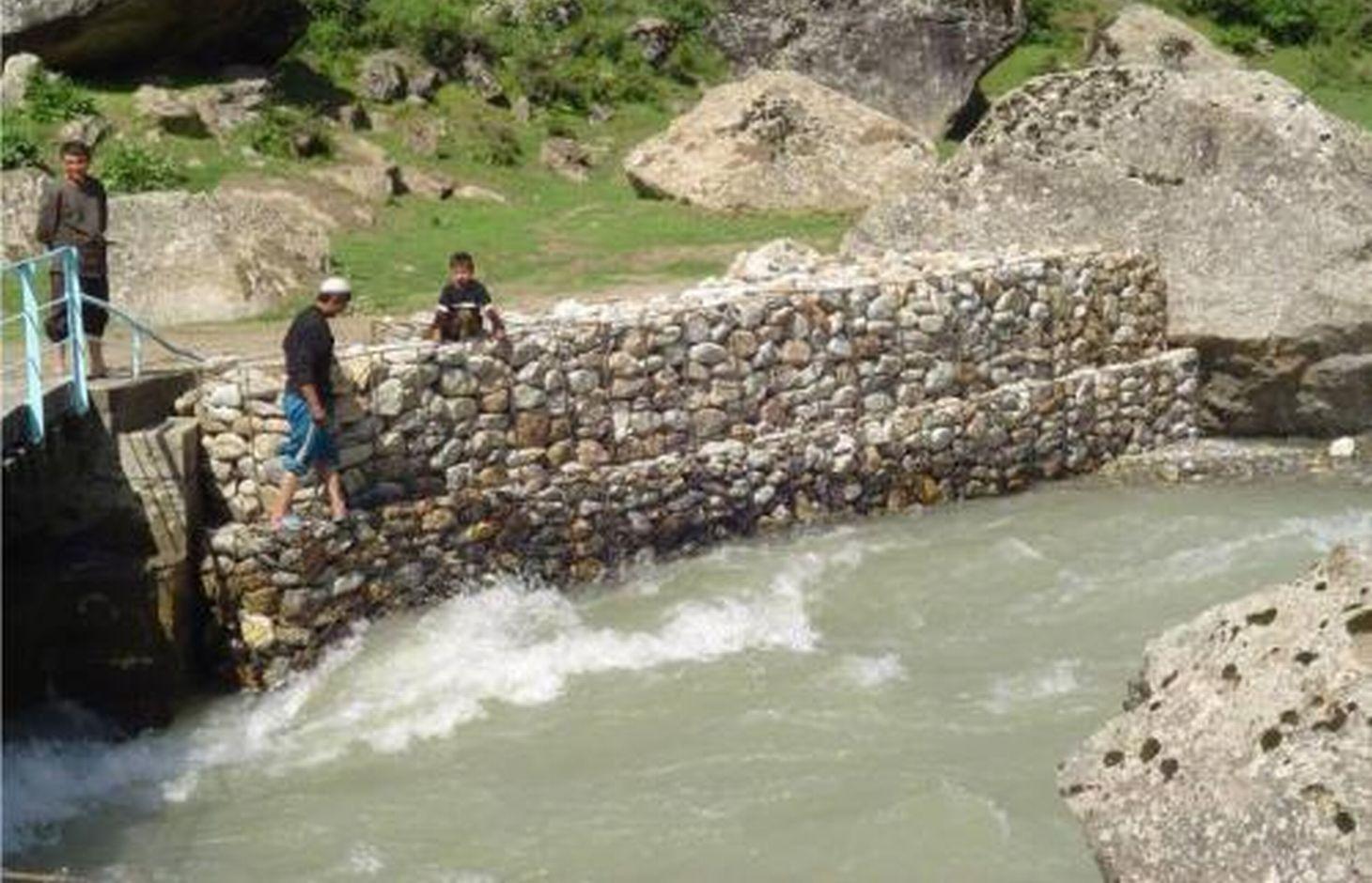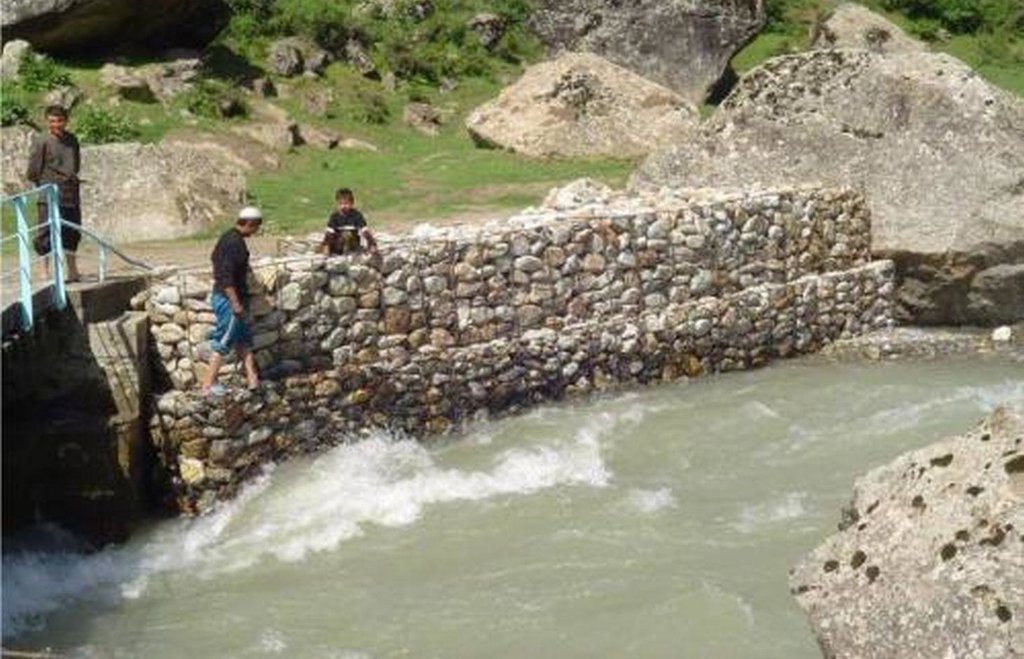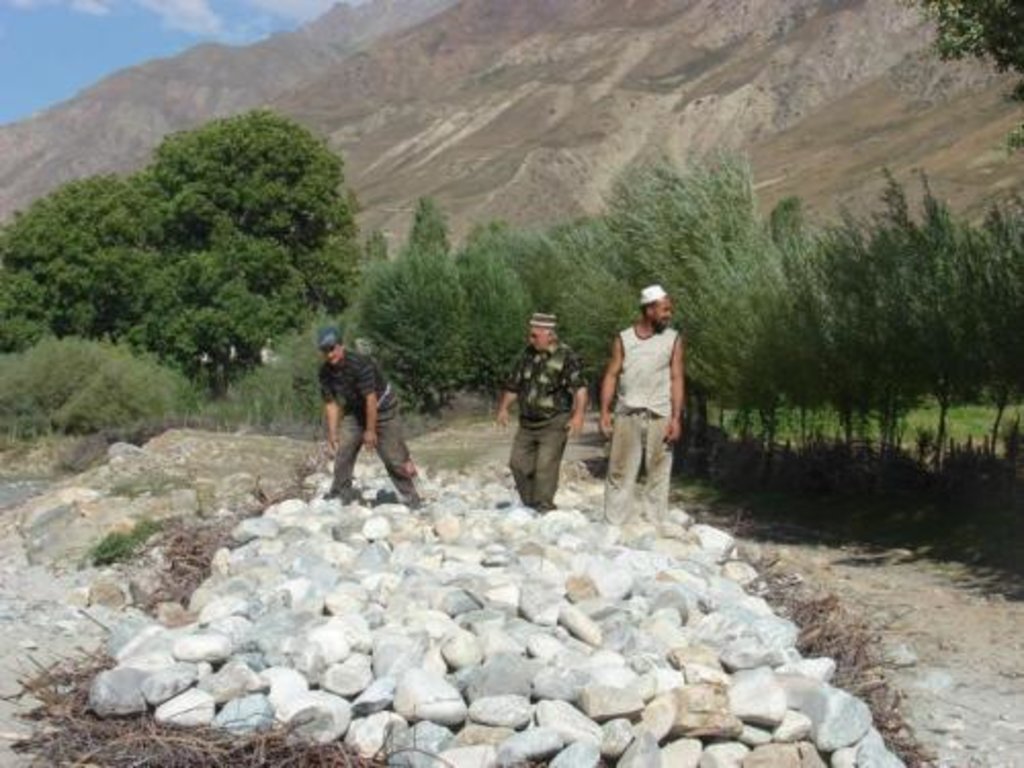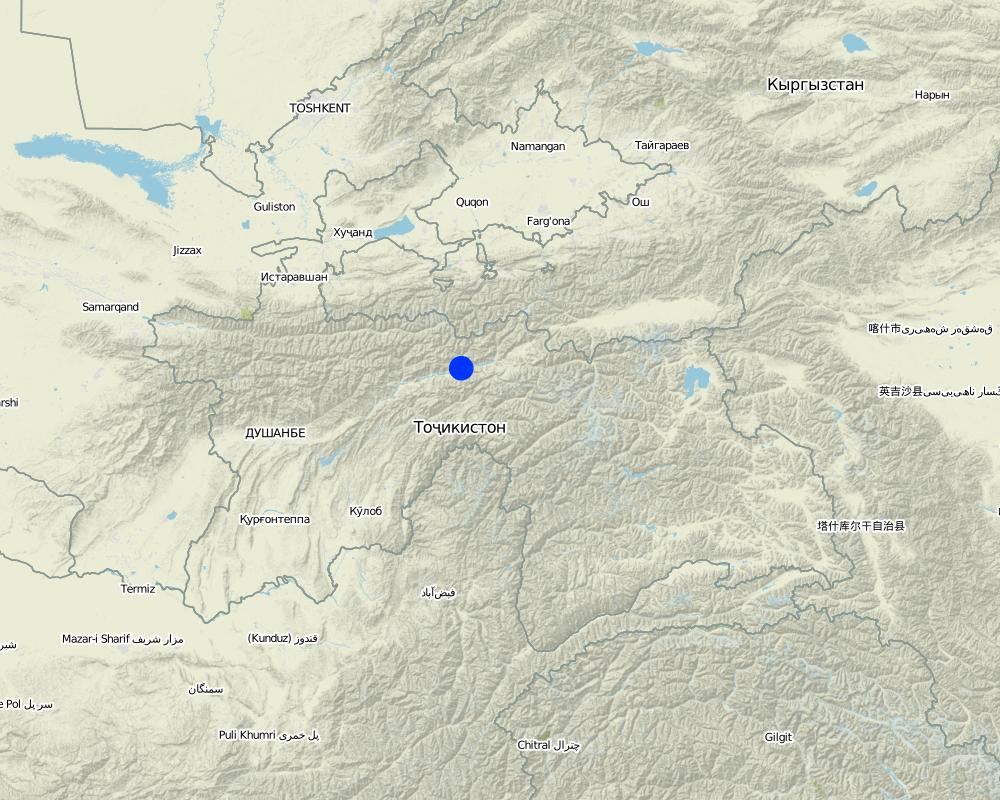Strengthening of river banks with stones and gabions [Tajikistan]
- Creation:
- Update:
- Compiler: German Kust
- Editor: –
- Reviewers: David Streiff, Alexandra Gavilano
Strengthening of the river banks with stones and gabions (English)
technologies_1362 - Tajikistan
- Full summary as PDF
- Full summary as PDF for print
- Full summary in the browser
- Full summary (unformatted)
- Strengthening of river banks with stones and gabions: March 21, 2017 (inactive)
- Strengthening of river banks with stones and gabions: July 31, 2017 (inactive)
- Strengthening of river banks with stones and gabions: Feb. 14, 2020 (inactive)
- Strengthening of river banks with stones and gabions: Nov. 2, 2021 (public)
View sections
Expand all Collapse all1. General information
1.2 Contact details of resource persons and institutions involved in the assessment and documentation of the Technology
SLM specialist:
Rustam Rakhimov
Community Agriculture and Watershed Management project in Tajikistan
Tajikistan
Name of project which facilitated the documentation/ evaluation of the Technology (if relevant)
Community Agriculture and Watershed Management project in Tajikistan (WB / CAWMP)1.3 Conditions regarding the use of data documented through WOCAT
When were the data compiled (in the field)?
22/05/2011
The compiler and key resource person(s) accept the conditions regarding the use of data documented through WOCAT:
Yes
2. Description of the SLM Technology
2.1 Short description of the Technology
Definition of the Technology:
Strengthening of river banks and counter landslide operations with the use of stones and gabions
2.2 Detailed description of the Technology
Description:
The technology includes collection of stones of average size (with the diameter of 20-40cm) and laying them in a specific way in places that are most affected by the water flow and which are prone to washout. Stones will protect arable and inhabited areas from washouts. There are two traditional ways for laying stones: (1) in the form of gabions or, in other words, stones are laid in the form of vertical walls bounded with wire, (2) in the form of masonry when stones are laid on branches of trees and shrubs.
Purpose of the Technology: Preventing river banks from being washed out by water flow and mudslides.
Establishment / maintenance activities and inputs: Collection of stones and tree branches, laying them down in a specific way, tying stones with tree branches or wire.
Natural / human environment: The technology is applicable to any river banks in rural settlements.
2.3 Photos of the Technology
2.5 Country/ region/ locations where the Technology has been applied and which are covered by this assessment
Country:
Tajikistan
Region/ State/ Province:
Tajikistan
Further specification of location:
Tajikobod region, Jamoats of Shirinchashma and Shagodaev
Map
×2.6 Date of implementation
If precise year is not known, indicate approximate date:
- more than 50 years ago (traditional)
2.7 Introduction of the Technology
Specify how the Technology was introduced:
- as part of a traditional system (> 50 years)
3. Classification of the SLM Technology
3.1 Main purpose(s) of the Technology
- protect a watershed/ downstream areas – in combination with other Technologies
3.2 Current land use type(s) where the Technology is applied

Cropland
- Annual cropping

Mixed (crops/ grazing/ trees), incl. agroforestry
- Silvo-pastoralism
Comments:
Major land use problems (compiler’s opinion): Washout of river banks by water and mudslides, reduction of arable land,
Major land use problems (land users’ perception): Washout of river banks by water and mudslides, reduction of arable land
Mixed: (eg agro-pastoralism, silvo-pastoralism): Yes
Future (final) land use (after implementation of SLM Technology): Other: Os: Settlements, infrastructure networks
Livestock is grazing on crop residues
Constraints of settlement / urban: Risk of washouts
If land use has changed due to the implementation of the Technology, indicate land use before implementation of the Technology:
Other: Os: Settlements, infrastructure networks
3.3 Further information about land use
Water supply for the land on which the Technology is applied:
- mixed rainfed-irrigated
Comments:
Водопотребление: смешанное богарно-орошаемое, смешанное богарно-орошаемое
Number of growing seasons per year:
- 1
3.4 SLM group to which the Technology belongs
- surface water management (spring, river, lakes, sea)
3.5 Spread of the Technology
Specify the spread of the Technology:
- evenly spread over an area
If the Technology is evenly spread over an area, indicate approximate area covered:
- 1-10 km2
Comments:
A total of 6 subprojects on strengthening of river banks have been implemented in the frameworks of the World Bank’s CAWMP project. This data basically refers to the Tajikobod region
3.6 SLM measures comprising the Technology

vegetative measures
- V1: Tree and shrub cover

structural measures
- S6: Walls, barriers, palisades, fences

management measures
- M3: Layout according to natural and human environment
Comments:
Main measures: structural measures
Secondary measures: vegetative measures, management measures
Type of vegetative measures: aligned: -linear, in blocks
3.7 Main types of land degradation addressed by the Technology

soil erosion by water
- Wr: riverbank erosion
Comments:
Main type of degradation addressed: Wr: riverbank erosion
Main causes of degradation: Heavy / extreme rainfall (intensity/amounts), floods
Secondary causes of degradation: over-exploitation of vegetation for domestic use, other natural causes (avalanches, volcanic eruptions, mud flows, highly susceptible natural resources, extreme topography, etc.) specify
3.8 Prevention, reduction, or restoration of land degradation
Specify the goal of the Technology with regard to land degradation:
- prevent land degradation
Comments:
Secondary goals: mitigation / reduction of land degradation, rehabilitation / reclamation of denuded land
4. Technical specifications, implementation activities, inputs, and costs
4.2 Technical specifications/ explanations of technical drawing
Technical knowledge required for field staff / advisors: moderate (Must have engineering education (hydrotechnical))
Technical knowledge required for land users: moderate (Must be experienced in setting up such kind of structures)
Main technical functions: stabilisation of soil (eg by tree roots against land slides)
Secondary technical functions: control of concentrated runoff: impede / retard, control of concentrated runoff: drain / divert
Aligned: -linear
Vegetative material: T : trees / shrubs
In blocks
Vegetative material: T : trees / shrubs
Trees/ shrubs species: Trees and shrubs are planted after installation of gabions
Wall/ barrier
Height of bunds/banks/others (m): 1-3
Width of bunds/banks/others (m): 0,5-5
Length of bunds/banks/others (m): 5-20
Construction material (earth): When laying down stones on branches of trees, spaces between branches are filled with sediments
Construction material (stone): main material that withstands water flows and mudslides
Construction material (wood): Branches of trees are used to tie stones together and to create mats
Construction material (other): Metal wire is used to bind stones
Vegetation is used for stabilisation of structures.
Change of land use practices / intensity level: Previously dangerous areas are now successfully used
Layout change according to natural and human environment: Preserving previously dangerous areas
4.4 Establishment activities
| Activity | Type of measure | Timing | |
|---|---|---|---|
| 1. | Collection of cuttings | Vegetative | |
| 2. | Cuttings of poplar and willow trees or sea-buckthorn | Vegetative | |
| 3. | Planting the cuttings | Vegetative | |
| 4. | Collection and transportation of stones | Structural | |
| 5. | Collection and transportation of branches of trees | Structural | |
| 6. | Layout of mats or stones | Structural | |
| 7. | Fixing stones in gabions | Structural | |
| 8. | Design of structures | Management | |
| 9. | Organization of works | Management |
4.6 Maintenance/ recurrent activities
| Activity | Type of measure | Timing/ frequency | |
|---|---|---|---|
| 1. | Replacement of destroyed sections of stones | Structural | |
| 2. | Planting the cuttings | Structural | |
| 3. | Maintenance of structures | Management | |
| 4. | Repair works | Management |
4.7 Costs and inputs needed for maintenance/ recurrent activities (per year)
Comments:
$200-$800 USD costs are calculated for 1 running meter of the average structure with the use of manual labor
4.8 Most important factors affecting the costs
Describe the most determinate factors affecting the costs:
Season, distance of transportation of stones, height of the structure, width and thickness of the structure, opportunity to mechanise works
5. Natural and human environment
5.1 Climate
Annual rainfall
- < 250 mm
- 251-500 mm
- 501-750 mm
- 751-1,000 mm
- 1,001-1,500 mm
- 1,501-2,000 mm
- 2,001-3,000 mm
- 3,001-4,000 mm
- > 4,000 mm
Agro-climatic zone
- sub-humid
- semi-arid
Thermal climate class: temperate
5.2 Topography
Slopes on average:
- flat (0-2%)
- gentle (3-5%)
- moderate (6-10%)
- rolling (11-15%)
- hilly (16-30%)
- steep (31-60%)
- very steep (>60%)
Landforms:
- plateau/plains
- ridges
- mountain slopes
- hill slopes
- footslopes
- valley floors
Altitudinal zone:
- 0-100 m a.s.l.
- 101-500 m a.s.l.
- 501-1,000 m a.s.l.
- 1,001-1,500 m a.s.l.
- 1,501-2,000 m a.s.l.
- 2,001-2,500 m a.s.l.
- 2,501-3,000 m a.s.l.
- 3,001-4,000 m a.s.l.
- > 4,000 m a.s.l.
Comments and further specifications on topography:
Slopes on average: Also gentle
5.3 Soils
Soil depth on average:
- very shallow (0-20 cm)
- shallow (21-50 cm)
- moderately deep (51-80 cm)
- deep (81-120 cm)
- very deep (> 120 cm)
5.4 Water availability and quality
Availability of surface water:
excess
5.6 Characteristics of land users applying the Technology
Market orientation of production system:
- mixed (subsistence/ commercial
Off-farm income:
- > 50% of all income
Relative level of wealth:
- poor
Individuals or groups:
- groups/ community
Level of mechanization:
- manual work
- mechanized/ motorized
Gender:
- women
- men
Indicate other relevant characteristics of the land users:
Land users applying the Technology are mainly common / average land users
Population density: 50-100 persons/km2
Annual population growth: 2% - 3%
5.7 Average area of land owned or leased by land users applying the Technology
- < 0.5 ha
- 0.5-1 ha
- 1-2 ha
- 2-5 ha
- 5-15 ha
- 15-50 ha
- 50-100 ha
- 100-500 ha
- 500-1,000 ha
- 1,000-10,000 ha
- > 10,000 ha
Is this considered small-, medium- or large-scale (referring to local context)?
- small-scale
Comments:
Average area of land owned or leased by land users applying the Technology: < 0.5 ha, 0.5-1 ha, 1-2 ha
5.8 Land ownership, land use rights, and water use rights
Land ownership:
- communal/ village
- individual, titled
Land use rights:
- communal (organized)
- individual
5.9 Access to services and infrastructure
health:
- poor
- moderate
- good
education:
- poor
- moderate
- good
technical assistance:
- poor
- moderate
- good
employment (e.g. off-farm):
- poor
- moderate
- good
markets:
- poor
- moderate
- good
energy:
- poor
- moderate
- good
roads and transport:
- poor
- moderate
- good
drinking water and sanitation:
- poor
- moderate
- good
financial services:
- poor
- moderate
- good
6. Impacts and concluding statements
6.1 On-site impacts the Technology has shown
Socio-economic impacts
Production
production area
Income and costs
workload
Socio-cultural impacts
food security/ self-sufficiency
community institutions
conflict mitigation
Livelihood and human well-beeing
Comments/ specify:
New land areas could be taken under production. These areas can be used without any risks
Ecological impacts
Soil
soil loss
Climate and disaster risk reduction
flood impacts
6.2 Off-site impacts the Technology has shown
damage on neighbours' fields
6.3 Exposure and sensitivity of the Technology to gradual climate change and climate-related extremes/ disasters (as perceived by land users)
Gradual climate change
Gradual climate change
| Season | Type of climatic change/ extreme | How does the Technology cope with it? | |
|---|---|---|---|
| annual temperature | increase | well |
Climate-related extremes (disasters)
Meteorological disasters
| How does the Technology cope with it? | |
|---|---|
| local rainstorm | not well |
| local windstorm | well |
Climatological disasters
| How does the Technology cope with it? | |
|---|---|
| drought | well |
Hydrological disasters
| How does the Technology cope with it? | |
|---|---|
| general (river) flood | not well |
Other climate-related consequences
Other climate-related consequences
| How does the Technology cope with it? | |
|---|---|
| reduced growing period | well |
6.4 Cost-benefit analysis
How do the benefits compare with the establishment costs (from land users’ perspective)?
Long-term returns:
positive
How do the benefits compare with the maintenance/ recurrent costs (from land users' perspective)?
Long-term returns:
positive
Comments:
It is difficult to assess economic benefits since prevented risks can be very expensive in terms of rehabilitation works in critical situations
6.5 Adoption of the Technology
- more than 50%
If available, quantify (no. of households and/ or area covered):
76 housheolds
Of all those who have adopted the Technology, how many have did so spontaneously, i.e. without receiving any material incentives/ payments?
- 0-10%
Comments:
100% of land user families have adopted the Technology with external material support
Comments on acceptance with external material support: This is the number of families who have applied this technology in the frameworks of the CAWMP Project
There is a moderate trend towards spontaneous adoption of the Technology
Comments on adoption trend: These technologies are traditional for Tajikistan, but they are quite expensive and need supporting funds
6.7 Strengths/ advantages/ opportunities of the Technology
| Strengths/ advantages/ opportunities in the land user’s view |
|---|
| Less critical situations |
| Strengths/ advantages/ opportunities in the compiler’s or other key resource person’s view |
|---|
|
Cheapness of local materials (since only transportation of materials is paid) How can they be sustained / enhanced? always |
|
Engineering simplicity of the structures How can they be sustained / enhanced? Till there are experienced masters and engineers |
|
Opportunity to reduce land use risks in critical areas How can they be sustained / enhanced? Till existing structures are maintained |
6.8 Weaknesses/ disadvantages/ risks of the Technology and ways of overcoming them
| Weaknesses/ disadvantages/ risks in the land user’s view | How can they be overcome? |
|---|---|
| Structures can be destroyed by floods or mudslides | Make structures more stable, use modern technologies |
| Weaknesses/ disadvantages/ risks in the compiler’s or other key resource person’s view | How can they be overcome? |
|---|---|
| Structures can be destroyed by floods or mudslides | Make structures more stable, use modern technologies |
7. References and links
7.2 References to available publications
Title, author, year, ISBN:
Community agriculture and Watershed Management project's database
Available from where? Costs?
Project management team, for free
Links and modules
Expand all Collapse allLinks
No links
Modules
No modules





